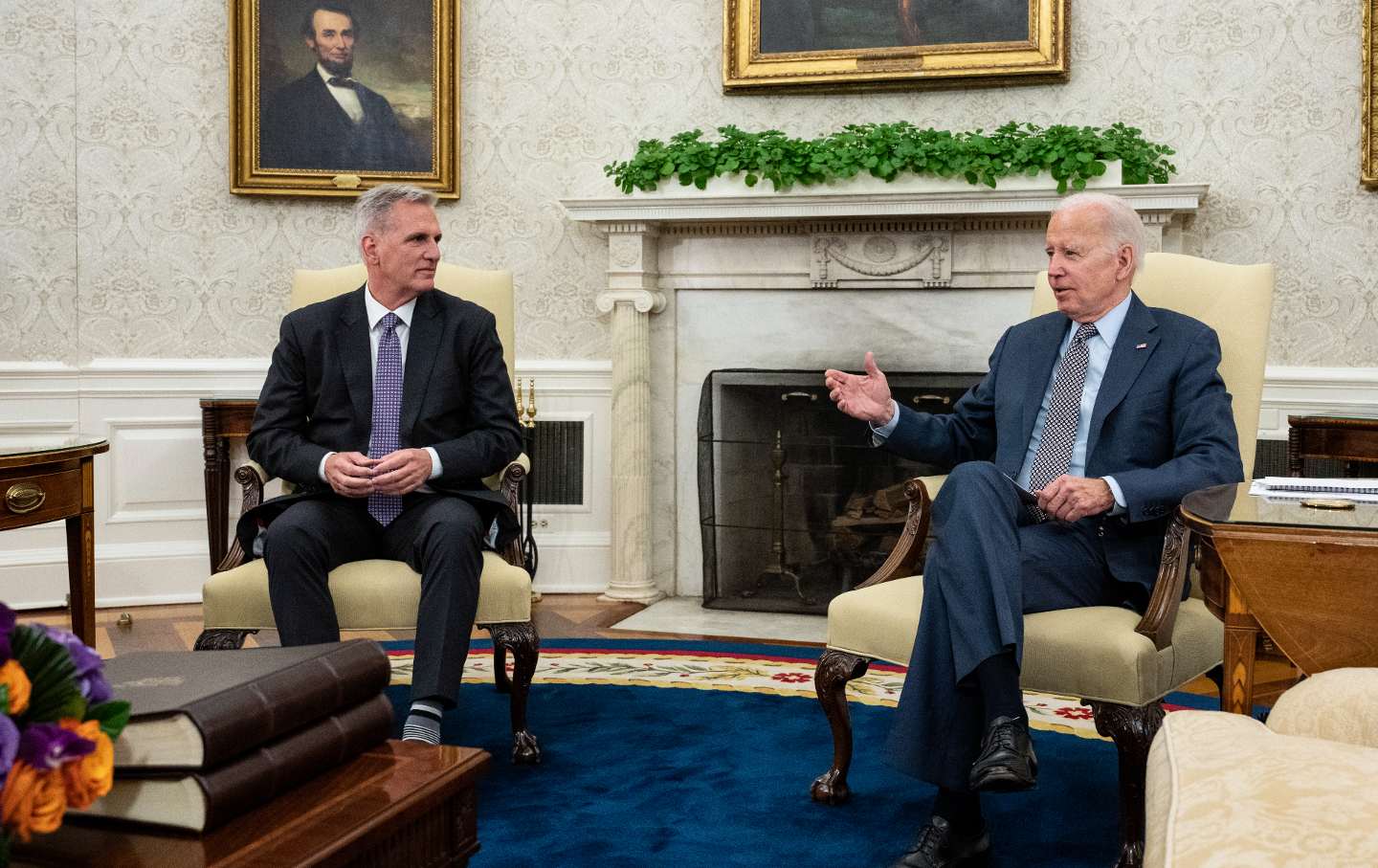
Joe Biden meets with House Speaker Kevin McCarthy in the Oval Office to discuss raising the debt limit in an effort to avoid a default by the federal government on May 22, 2023.(Drew Angerer / Getty Images)
Two men emerged from the Oval Office. One of them, President Joe Biden, said of the deal they’d just reached that it “reduces spending while protecting critical programs for working people and growing the economy for everyone.”
The other, House Speaker Kevin McCarthy, said that the deal will bring “historic reductions in spending, consequential reforms that will lift people out of poverty into the work force, rein in government overreach.”
Contrary to the president, the deal will not “grow the economy.” Contrary to the speaker, it will not “lift people out of poverty.” It spares the military, veterans, Social Security, and Medicare, focusing cuts and caps on non-defense, discretionary spending—which, as the Center for American Progress has explained, includes many of the most “essential programs.” Those cuts accumulate, and—as population grows and prices rise—they will be steep. True, the spending caps apply for only two years, but then the debt ceiling will come up again, and they will likely be renewed. The precedent has been set. Speaker McCarthy is right: The cuts are historic. The deal means austerity for the long term. It is a huge Republican win.
The deal, according to Peter Baker in The New York Times, contains “important changes in environmental permitting, work requirements for social safety-net programs, and Internal Revenue Service tax enforcement.” These are all gains for the Republican side. They benefit the oil and minerals industries and wealthy tax-evaders—bipartisan constituencies, though not the voting base of the Democratic Party. The “work requirements” for SNAP will make life harder for some of the poorest people in America.
What did the president get? An increase in the debt ceiling, until the next election is over, at which point the game gets to be played again. For this, Biden gave away the following previously held points of principle: (1) that the debt ceiling should be raised, when needed, without conditions; (2) that safety-net programs and tax enforcement are good and necessary; and (3) that domestic discretionary spending is not actually excessive but should be at levels required to meet public purpose and national needs. If Biden is reelected, these gifts will hobble his next administration. If he’s defeated, they set up the incoming president to use the debt ceiling to effect the full Republican agenda.
Were the concessions needed because of the gravity of the impending crisis? That is the biggest lie, shared by both parties, repeated by Wall Street, and amplified by the media, which loves a crisis and plays the public for fools.
There was no crisis. The administration had multiple pathways—under the law and the Constitution—to defuse the debt ceiling without giving anything away. It could have issued the platinum coin. The claim that the Supreme Court might have blocked it has been rebutted by Phillip Diehl, a former director of the Mint, who drafted the enabling legislation. He said as head of the Mint, “The fact that it can have a trillion-dollar denomination on it was absolutely part of the intent.” Or Treasury could have issued perpetual bonds, called consols, not covered by the ceiling because they have no principal to repay. It could (probably) have issued premium bonds. It could have asked the Federal Reserve to clear Treasury checks with a zero-interest, unsecured line of credit. It could, finally, have let some checks bounce, if it came to that, and relied on the big bankers, not to mention the outraged public, to whip Congress into line. There was no chance that a default “crisis” would fail to resolve in a few hours, at most.
The last point bears a few more words. Biden has declared that the United States has never defaulted on any debt. This is untrue. As an excellent recent paper by the historian Eric Toussaint points out, in April 1933, President Franklin Roosevelt abrogated the “gold clause” in all US debt contracts, including public debts, by executive order, and devalued the dollar, in terms of gold, from $20.67 to $35 per ounce, while banning most private holdings of gold. This was a massive default. Creditors challenged FDR’s action, and the Supreme Court found it unconstitutional, but only in principle. In a separate vote, the court found there were no damages, and the ban on gold remained in force until the 1970s. It devalued debts and effected a vast transfer of wealth to the working class. It was a key step toward economic recovery. Roosevelt was a fighter.
The debt-ceiling charade was a farce, but it reveals a tragedy. The tragedy is that the president did not want to fight. He did not want to defend any principle. He did not want to use the powers he had to protect and defend the American people. He did not want to stand with Democrats in Congress or his constituents in the Democratic Party. He wanted to be seen sitting, side by side, with the Republican speaker of the house. He wanted to get the plaudits of the pundit class, for “compromise” and for reaching a “bipartisan” deal.
Well, the president has what he wants. The speaker has what he wants. Let them defend the consequences.
James K. GalbraithJames K. Galbraith teaches economics at the Lyndon B. Johnson School of Public Affairs, The University of Texas at Austin. His new book is Entropy Economics: The Living Basis of Value and Production, co-authored with Jing Chen, published by the University of Chicago Press.